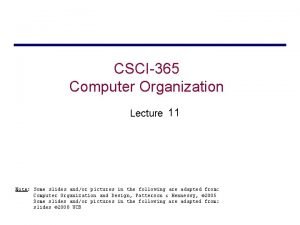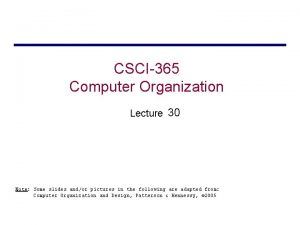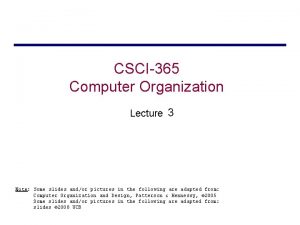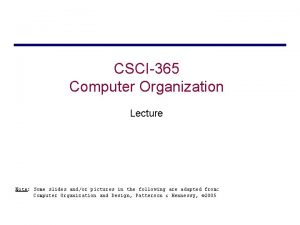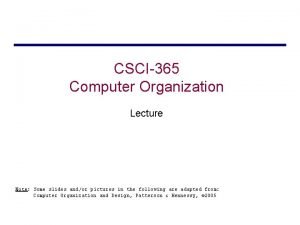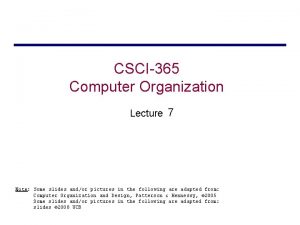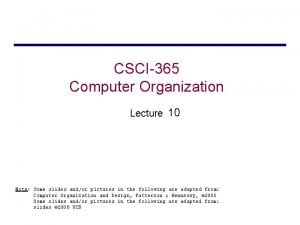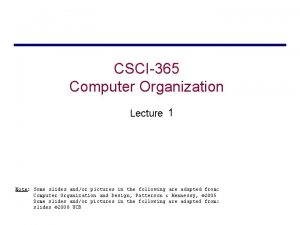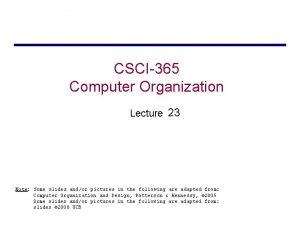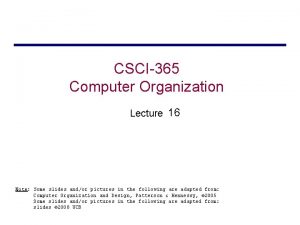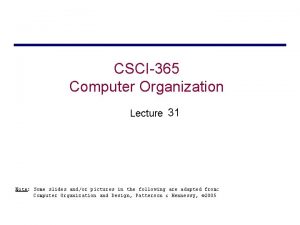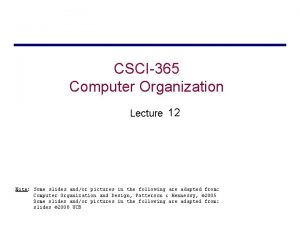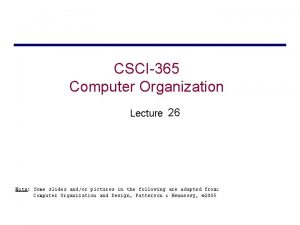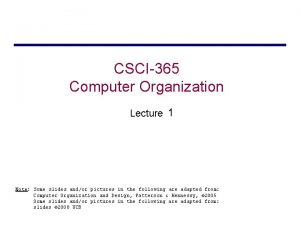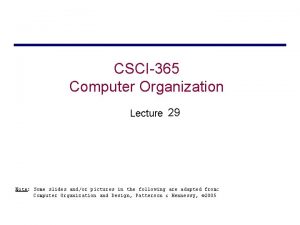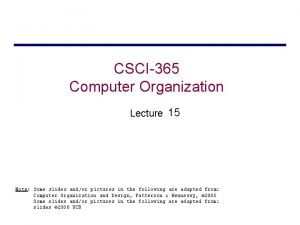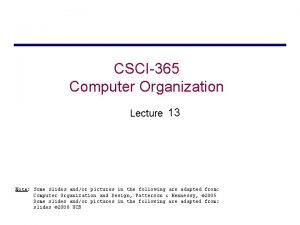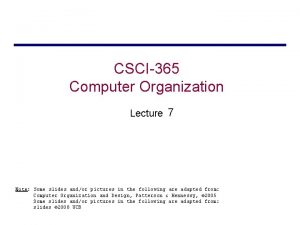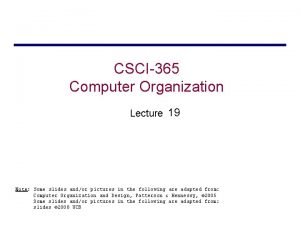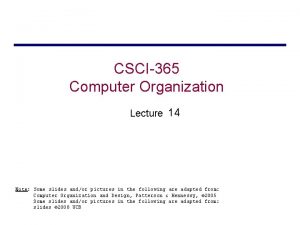CSCI365 Computer Organization Lecture 5 Note Some slides





















- Slides: 21

CSCI-365 Computer Organization Lecture 5 Note: Some slides and/or pictures in the following are adapted from: Computer Organization and Design, Patterson & Hennessy, © 2005 Some slides and/or pictures in the following are adapted from: slides © 2008 UCB

Function Call Bookkeeping • Registers play a major role in keeping track of information for function calls • Register conventions: – – Return address Arguments Return value Local variables $ra $a 0, $a 1, $a 2, $a 3 $v 0, $v 1 $s 0, $s 1, … , $s 7 • The stack is also used; more later

Function Call Bookkeeping. . . sum(a, b); . . . /* a, b: $s 0, $s 1 */ } int sum(int x, int y) { return x+y; } address 1000 add 1004 add 1008 addi 1012 j 1016. . . $a 0, $s 0, $zero # x = a $a 1, $s 1, $zero # y = b $ra, $zero, 1016 # $ra=1016 sum # jump to sum 2000 sum: add $v 0, $a 1 2004 jr $ra # new instruction

Function Call Bookkeeping. . . sum(a, b); . . . /* a, b: $s 0, $s 1 */ } int sum(int x, int y) { return x+y; } • Question: Why use jr here? Why not simply use j? – Answer: sum might be called by many places, so we can’t return to a fixed place. The calling proc to sum must be able to say “return here” somehow 2000 sum: add $v 0, $a 1 2004 jr $ra # new instruction

Function Call Bookkeeping • Single instruction to jump and save return address: jump and link (jal) • Before: 1008 addi $ra, $zero, 1016 #$ra=1016 1012 j sum #goto sum • After: 1008 jal sum # $ra=1012, goto sum • Why have a jal? Make the common case fast: function calls are very common. Also, you don’t have to know where the code is loaded into memory with jal

Function Call Bookkeeping • Syntax for jal (jump and link) is same as for j (jump): jal label • jal should really be called laj for “link and jump”: – Step 1 (link): Save address of next instruction into $ra (Why next instruction? Why not current one? ) – Step 2 (jump): Jump to the given label

Function Call Bookkeeping • Syntax for jr (jump register): jr register • Instead of providing a label to jump to, the jr instruction provides a register which contains an address to jump to • Very useful for function calls: – jal stores return address in register ($ra) – jr $ra jumps back to that address

Nested Procedures int sum. Square(int x, int y) { return mult(x, x)+ y; } • Something called sum. Square, now sum. Square is calling mult • So there’s a value in $ra that sum. Square wants to jump back to, but this will be overwritten by the call to mult • Need to save sum. Square return address before call to mult

Nested Procedures • In general, may need to save some other info in addition to $ra • When a program is run, there are 3 important memory areas allocated: – Static: Variables declared once per program, cease to exist only after execution completes. E. g. , C globals – Heap: Variables declared dynamically – Stack: Space to be used by procedure during execution; this is where we can save register values

Memory Allocation Address ¥ $sp stack pointer 0 Stack Space for saved procedure information Heap Explicitly created space, e. g. , malloc(); C pointers Static Variables declared once per program Code Program

The Stack The register scratchpad for a procedure seems volatile – it seems to disappear every time we switch procedures – a procedure’s values are therefore backed up in memory on a stack High address Proc A’s values call Proc B … call Proc C … return Proc B’s values Proc C’s values … Stack grows this way Low address return

Using the Stack • So we have a register $sp which always points to the last used space in the stack • To use stack, we decrement this pointer by the amount of space we need and then fill it with info • So, how do we compile this? int sum. Square(int x, int y) { return mult(x, x)+ y; }

Using the Stack int sum. Square(int x, int y) { sum. Square: return mult(x, x)+ y; } addi $sp, -8 # space on stack “push” sw $ra, 4($sp) # save ret addr sw $a 1, 0($sp) # save y add $a 1, $a 0, $zero # mult(x, x) “pop” jal mult # call mult lw $a 1, 0($sp) # restore y add $v 0, $a 1 # mult()+y lw $ra, 4($sp) # get ret addr addi $sp, 8 # restore stack jr $ra mult: . . .

Steps for Making a Procedure Call • Save necessary values onto stack • Assign argument(s), if any • jal call • Restore values from stack

Rules for Procedures • Called with a jal instruction, returns with a jr $ra • Accepts up to 4 arguments in $a 0, $a 1, $a 2 and $a 3 • Return value is always in $v 0 (and if necessary in $v 1) • Must follow register conventions. So what are they?

Register Conventions • Calle. R: the calling function • Calle. E: the function being called • When callee returns from executing, the caller needs to know which registers are guaranteed to be unchanged (saved registers) and which registers may have changed (volatile registers) • Register Conventions: A set of generally accepted rules as to which registers will be unchanged after a procedure call (jal) and which may be changed

Register Conventions - saved • $0: No Change. Always 0 • $s 0 -$s 7: Restore if you change. Very important, that’s why they’re called saved registers. If the callee changes these in any way, it must restore the original values before returning • $sp: Restore if you change. The stack pointer must point to the same place before and after the jal call, or else the caller won’t be able to restore values from the stack • HINT – All saved registers start with S!

Register Conventions - volatile • $ra: Can Change. The jal call itself will change this register. Caller needs to save on stack if nested call • $v 0 -$v 1: Can Change. These will contain the new returned values • $a 0 -$a 3: Can Change. These are volatile argument registers. Caller needs to save if they’ll need them after the call • $t 0 -$t 9: Can Change. That’s why they’re called temporary: any procedure may change them at any time. Caller needs to save if they’ll need them afterwards

Register Conventions • What do these conventions mean? – If function R calls function E, then function R must save any temporary registers that it may be using onto the stack before making a jal call – Function E must save any S (saved) registers it intends to use before garbling up their values – Remember: Caller/callee need to save only temporary/saved registers they are using, not all registers

Basic Structure of a Function Prologue entry_label: addi $sp, -framesize sw $ra, framesize-4($sp) # save $ra save other regs if need be. . . Body (call other functions…) Epilogue restore other regs if need be lw $ra, framesize-4($sp) # restore $ra addi $sp, framesize jr $ra ra memory

Example 1 int leaf_example (int g, int h, int i, int j) { int f ; f = (g + h) – (i + j); return f; } Compile into MIPS (done in class)
 Process organization in computer organization
Process organization in computer organization A small child slides down the four frictionless slides
A small child slides down the four frictionless slides A crane lowers a girder into place at constant speed
A crane lowers a girder into place at constant speed Principles of economics powerpoint lecture slides
Principles of economics powerpoint lecture slides Ethem alpaydin
Ethem alpaydin Business communication lecture slides
Business communication lecture slides 01:640:244 lecture notes - lecture 15: plat, idah, farad
01:640:244 lecture notes - lecture 15: plat, idah, farad Lecture note tiu
Lecture note tiu Basic structure of computer system
Basic structure of computer system Difference between computer organization and architecture
Difference between computer organization and architecture Design of basic computer with flowchart
Design of basic computer with flowchart Flow chart for interrupt cycle
Flow chart for interrupt cycle Difference between note making and note taking
Difference between note making and note taking Example of signal words
Example of signal words Difference between note making and note taking
Difference between note making and note taking Goods received note vs delivery note
Goods received note vs delivery note Debit note format
Debit note format Debit note tax invoice
Debit note tax invoice Relevance of note making
Relevance of note making Simple discount rate
Simple discount rate Sometimes you win some
Sometimes you win some Sometimes you win some sometimes you lose some
Sometimes you win some sometimes you lose some






















